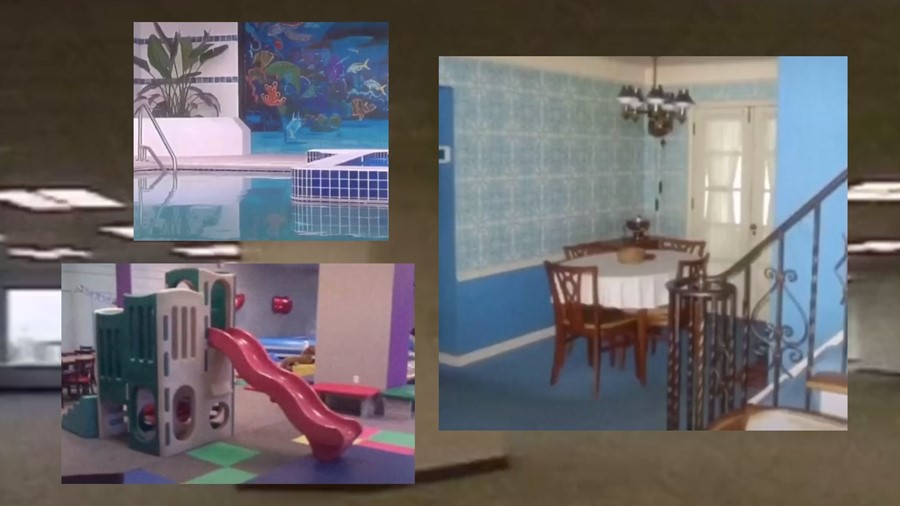A liminal space is the time between the ‘what was’ and the ‘next’, and it’s inspiring a strain of eerie TikToks that conjure feelings of nostalgia, lostness, and uncertainty
Flickering footage of a black and white storefront. Empty corridors and dimly lit backrooms. An old recording of a children’s birthday party circa 2002. This is what you see when you enter the feverish, dreamlike world of liminal TikTok. Containing trigger warnings like ‘derealisation’ and ‘depersonalisation’, these uncanny videos bring together montages of murky yet strangely familiar scenes of often abandoned spaces to evoke a sense of nostalgia, lostness, and uncertainty.
It has inspired videos with more than 98.5 million combined views on TikTok of teenagers pretending they are in 2005 or pointing out “pictures that feel strangely familiar but uncomfortable”. Comments on the videos hint at a peculiar, unsettling kind of nostalgia: “I can’t believe I wanted to grow up,” laments one user. “I’m sitting in my bed at 1am. I am 18 years old. Where did time go,” says another.
On the surface, liminal spaces can be defined by their in between-ness. Places like airports, hotels, and train stations can be described as liminal, but it can also describe existential feelings of being neither here nor there. In the context of the pandemic, liminality takes on a metaphorical meaning, as we sit in our homes contemplating what life was like before and what it will become again in the future. It’s perhaps unsurprising that the most popular recurring images of liminal spaces are of abandoned shopping centres, empty hallways, and barren parking lots – spaces that were formerly occupied and have since fallen into unuse and decay.
The internet’s fascination with liminal spaces can be traced back to 2019, when a short creepypasta (internet folklore) of a hallway with sickly yellow carpets and wallpaper was posted to 4chan and went viral. “If you’re not careful and you noclip out of reality in the wrong areas, you’ll end up in the Backrooms, where it’s nothing but the stink of old moist carpet… and approximately six hundred million square miles of randomly segmented empty rooms to be trapped in,” it warned. Since then, similar images of eerie and uninhabited spaces have inspired subreddits, Instagram accounts, and TikToks. While the #liminalspaces hashtag has been viewed over 98 million times, associated hashtag #dreamcore has clocked up 257 million and #weirdcore, 186 million.
Despite their somewhat creepy origins, TikTok’s obsession with liminal spaces is rooted in a romanticised version of the past. Many of the clips use footage from the 90s or early 2000s, which is funny considering that many of the teens posting these videos weren’t even born yet. Filtered through the lens of fuzzy and imperfect VHS tapes, they imagine a bleary, pre-internet world of playgrounds and bouncy castles and boldly patterned 90s carpets; bulky televisions and old McDonalds adverts.
@valiumdreams 2008 birthday 🎂🎈 yt: piezon84 ##liminalspaces ##dreamcore ##weirdcore ##aesthetic ##nostalgia ##birthday ##feverdream ##surreal ##fyp
♬ original sound - creepy slowed audios
There’s certainly an unease to the clips, but there’s alluring nostalgia too. Liminal spaces have an almost algorithmic feel to them. They often rely on generic imagery that mingles with your own fond memories of childhood to bring forth feelings that are both recognisable and completely unfamiliar. Often, these locations are loaded with references to childhood – playgrounds, children’s parties – which serve only as a reminder of this loss of innocence.
“Each photo or video can give off hundreds of different emotions from hundreds of different people. They tell a story, but it differs from person to person,” says TikTok user @valiumdreams, who makes regular liminal TikToks for her 80k followers. “I also just miss the 2000s. Making these videos sends me and the viewers right back to those simple, happy times. I personally think that this type of content has become popularized on TikTok because it gives the viewer a sense of familiarity and a dose of nostalgia that they may have forgotten or been missing from their childhood.”
“I personally think that this type of content has become popularized on TikTok because it gives the viewer a sense of familiarity and a dose of nostalgia that they may have forgotten or been missing from their childhood”
One of @valiumdreams’ most popular videos is homemade footage of a birthday party at Pump It Up, an indoor soft play chain in the United States. “The comments are made up of people sharing their stories of when they celebrated their birthday there as a child, and how much they miss it,” she says. The video, which has nearly two million likes, features bright primary colours and snapshots of birthday lunch table arrangements. You can practically taste the early-noughties menu of chicken nuggets and chips, or imagine the inevitable party bag stuffed with small plastic toys and slices of supermarket-bought birthday cake. As one user puts it: “It hurts that I’ll never get it back”.
The clip is accompanied by Hisohkah’s “School Rooftop”, a track commonly found on lofi and chillhop playlists. Its melancholic sound helps to amplify the sense of nostalgia: “It gives off more of a sad, longing, and sentimental feel, which is what I was going for – to make the viewer happy yet longing for something at the same time,” says @valiumdreams.
@childh00dreams lets have fun. :) ##fyp ##viral ##scary ##2000s ##childhood ##nostalgia ##memories ##liminalspaces ##dream ##2010 ##school ##elementaryschool
♬ original sound - .
In his 2014 essay collection Ghosts of My Life, British cultural theorist Mark Fisher writes about the “slow cancellation of the future,” or the inability to see the world as removed from neoliberalist powers that be. A byproduct of this is the inclination towards nostalgia in popular culture and the endless regurgitation of old styles. Examples of this phenomena are far-reaching, from cottagecore and goblincore’s fascination with bucolic, pre-internet lifestyles to the return of emo and scene kid subcultures; the romanticisation of past eras in contemporary pop music and the retro sheen of Netflix dramas like Sex Education and I Am Not Okay, where modern characters exist in seemingly pre-modern worlds. Netflix is “creating a space where the past never dies,” The Atlantic’s Sophie Gilbert observed last year, with new shows “formed out of pieces of relics, liberated from the burden of having to say much that’s new at all.”
Similarly, liminal worlds hint at what Fisher referred to as a nostalgia for lost futures. By excavating artefacts from the past, we can cushion ourselves from the harsh realities of the present, providing a much-needed respite from the neverending flux of neoliberal ideologies and post-capitalist enterprises. Not to mention apps like TikTok that overwhelm us with new information a million miles a minute, and which are, themselves, geared towards audiences who are too young to remember otherwise.
It’s unsurprising, then, that many liminal TikTok videos feature soft, decomposing melodies that enhance the feeling of confusion and familiarity, as if looking back at the past through misted glass. Interestingly, some videos are soundtracked by The Caretaker – an alias of the British experimental musician Leyland James Kirby, who cites Fisher as one of his inspirations (Fisher wrote the liner notes to Kirby’s album Theoretically Pure Antiretrograde Amnesia), and whose music is built from edits of Jazz Age ballroom tunes found on forgotten 78s. As with liminal worlds, the music is dreamy and unsettling, like being stuck in the bleary realms of someone else’s distant memories.
@yourlocalbreadmanz visitors ##oddcore ##weirdcore ##dreamcore ##voidcore
♬ original sound - Bread man
“The images in the liminal scene invoke feelings and memories, many long forgotten or warped over time,” says TikTok user @yourlocalbreadmanz, whose surrealist and disturbing animations are listed under the hashtag #liminalspaces. “When you see a photo of your room, you are reminded of the atmosphere of being in there. When you see these liminal images, I feel as though the brain is trying to mash up every place, vibe, and atmosphere you’ve been to in order to match the feeling of the image.”
Unlike a majority of videos under the #liminalspaces hashtag, which rely on found footage of IRL places, @yourlocalbreadmanz imagines the liminal as a realm inhabited by strange and uncanny monsters, rather like the Backrooms in the original creepypasta. In doing so, his work evokes the art of surrealist painters such as Salvador Dalí and Renee Magritte, who also played on the barrenness of liminal spaces to conjure up disorientating and hypnagogic worlds. “I feel like because of recent times, much of our generation is hardened enough and old enough to start looking backwards towards the better days of their childhood, as the world we live in right now may be too painful to bear,” he adds. “Liminal images just capture that feeling of being somewhere you’ve been before in better times, but the beauty of it is that it’s personal to everyone.”
Whereas previous eras looked to the future for hope and excitement, with visions of flying cars and glossy technotopias, at present it’s hard to imagine a future at all, let alone one that warrants anything other than dread. Nostalgia, the literary theorist Fredric Jameson wrote, is “an alarming and pathological symptom of a society that has become incapable of dealing with time and history.” So, it’s no wonder that we’re seeing a saturation of nostalgic content. Young people on TikTok can now pacify themselves with the sounds of Fleetwood Mac’s 1977 chart-topper “Dreams” or cycle back through the summer of ’19. They can live out an idyllic country life and churn their own butter, or put on a pair of rose-tinted glasses and reminisce about the Backrooms.




